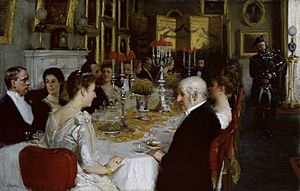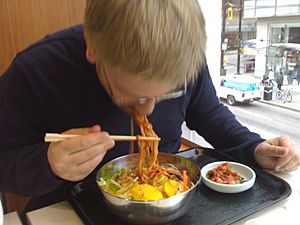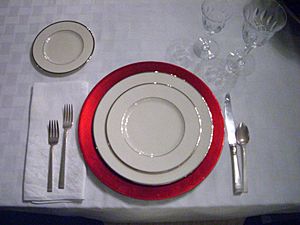Table manners in North America facts for kids
Table manners are the polite ways we act when we eat. They are like unwritten rules that help everyone enjoy their meal together. These rules can change over time and might be different depending on where you are eating, like at home, a restaurant, or even a special event.
Contents
A Look Back: How Table Manners Started
Table manners have a long and interesting history. Many of the things we do at the dinner table today come from traditions that started hundreds of years ago.
For example, in Europe, during a time called the Renaissance, people started thinking more about good manners. An Italian writer named Giovanni Della Casa wrote a book in 1558 about how to behave. He suggested that people should wash their hands before dinner, even if they didn't need to, just to show others they were clean.
Here are some other old rules that are still good advice today:
- When you eat bread, tear off small pieces instead of biting into the whole roll. Then, butter only the piece you are about to eat. (This rule is from 1532!)
- Keep your table conversations friendly and avoid talking about things that might cause arguments. (From 1576)
- If you need something on the table that you can't reach, politely ask the person closest to it to pass it to you. (From 1577)
- You can put your elbows on the table only between different parts of the meal, not while you are actually eating.
- Always chew with your mouth closed and try not to make loud noises when you eat.
- If food gets stuck in your teeth and you can't get it out with your tongue, it's best to excuse yourself from the table and fix it in private. (From 1609)
In the past, important leaders like Benjamin Franklin in America also wrote about good manners. In the 1800s, many books were published in the United States to teach people how to behave politely.
Table Manners at Home
Every family has its own special rules for mealtime. But some basic table manners are common in most homes. For example, it's usually not polite to pick your teeth at the table or chew with your mouth open.
Today, table manners at home are often more relaxed than they used to be, like in the 1950s. Some people even say it's okay to put your elbows on the table now! Many families also eat fast food without forks and knives, or they eat in front of the TV or in the car. This is different from how families used to gather around the dining table for every meal. Some people worry that these changes mean kids have fewer chances to learn good table manners at home.
Also, with new technology, many people wonder if it's okay to use smartphones at the dining table. People have different ideas about this.
Common Table Mistakes to Avoid
Long ago, tables were often wobbly. Leaning on them could make food spill! That's why the rule about not putting elbows on the table started. Now, it's more accepted to rest your elbows on the table, but usually only between different parts of the meal, not while you're eating.
Being quiet while eating is also important for safety. Choking on food is a serious concern.
In most places, it's not polite to complain or make rude comments about the food you are served. Also, blowing your nose at the table is considered rude. And making slurping noises when you eat is often seen as impolite.
Manners for Business Meals
Sometimes, important business talks happen over a meal. Good table manners can really help when you're eating with clients, co-workers, or your boss. Showing good manners can help you build good relationships, celebrate team successes, or just have a good discussion outside the office.
Some schools even have classes to teach students about dining etiquette because these skills are so important. Having poor table manners can affect how others see you and even change the outcome of a meeting.
Many polite habits from formal dining can be used in a business setting. However, some things might change depending on who is hosting and who is the guest. For example, talking with food in your mouth might be okay with close co-workers during a casual lunch. But in an important meeting with a potential client, it would likely seem rude.
Your Napkin should always be kept on your lap. If you need to leave the table for a moment, place your napkin on your chair. This tells the staff you're not finished. When you are completely done with your meal, place the napkin on the table next to your plate.
Unless the host says they will pay, you should expect to pay for your own meal. If someone else is paying, it's usually not polite to order the most expensive item on the menu.
The dress code for a business meal can change based on when it happens. For lunch, you'll probably wear what you wore to work. But special events might need more formal clothes. It's important to try and match how formal the event is. Good table manners actually start even before you sit down!
Dining Out: Restaurant Manners
The politeness level can change depending on how fancy the restaurant is.
Good table manners should start as soon as you sit down. The very first thing to do is put your napkin in your lap. If it's a cloth napkin, you don't need to unfold it all the way; just leave one fold. The napkin helps protect your clothes from spills.
It's helpful to know how to use the table setting. This means knowing which forks and spoons to use and which items are for you. A simple rule is to start with the utensils on the outside and work your way in. For example, if you have two forks and you're starting with a salad, use the fork farthest from your plate. The one closer to your plate is for the main course. If you start with soup, pick the spoon farthest from your plate.
Many restaurants set the table with a bread plate and a water glass for each person. The bread plate is on your left, and your drink is on your right. If you forget which is yours, here's a trick:
- Touch your left index finger to your left thumb. You'll see a lowercase b, which stands for your bread plate.
- Touch your right index finger to your right thumb. You'll see a lowercase d, for your drinks.
Eating in North America is often a social event, not just about eating food. So, a good way to show respect to the people you're with is to ignore your cell phone while dining. Studies show that many people think it's okay to use phones in restaurants, but that number drops a lot for family dinners or important meetings.
When it's time to pay the bill in American restaurants, leaving a tip for the waiter is a common custom. Most Americans always leave a tip, usually between 16% and 20% of the total bill.




